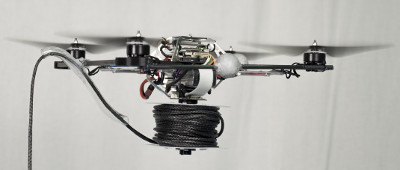| Drones Build A Rope Bridge |
| Written by Mike James | |||
| Sunday, 20 September 2015 | |||
|
Drones are either for fun, snooping or, less likely, delivery services - but what about construction? RTH Zurich has at last done something that really proves that drones could be useful in the very near future, building a bridge that humans can walk across. OK, it was only a rope bridge, but then again what is a suspension bridge other than a rope bridge with ambition! This is the latest success from an ongoing project at RTH Zurich and the video was made in its Flying Machine Arena, which has been the location for a large number of "drones doing amazing things" videos. In this case what the drones are doing looks interesting, but it is the final crossing by humans that really evokes the "gee whiz" moment:
The quadcopters have a motorized spool that allows them to control the tension of the rope - you can see this happening best in when they build the stabilizer at the end of the video. The forces generated by the rope have to be taken into account by the control algorithm. The positions of the drones is monitored via cameras.
Of course, this is an indoor environment and putting a rope bridge across a real "Indiana Jones" style canyon would be a more difficult problem. But you can already see it's not impossible. The bridge spans 7.4m and the quadcopters used about 120m of high strength, low weight rope. If you needed the bridge to be stronger you could simply get the robots to double or treble the number of ropes used. If things keep moving in this direction perhaps drones could do all of the assembly on a site and make cranes a thing of the past. The big problem is lifting capacity, but breaking things down into smaller components would make this easier. To quote the research team: "Flying machines offer a number of advantages compared to traditional construction machines. Specifically, they can reach any point in space and fly in or around existing objects. However, they also have drawbacks, such as limited payload and accuracy. Tensile structures fit very well this combination of characteristics and constraints.."
More InformationRelated ArticlesFlying Ball Drone Wins $1 Million Prize Not A Drone Army But a Drone Orchestra Nano Quadcopter - Your Personal Flying Robot Flying Neural Net Avoids Obstacles You're Never Alone With A Joggobot Quadrotor To be informed about new articles on I Programmer, install the I Programmer Toolbar, subscribe to the RSS feed, follow us on, Twitter, Facebook, Google+ or Linkedin, or sign up for our weekly newsletter.
Comments
or email your comment to: comments@i-programmer.info |
|||
| Last Updated ( Sunday, 20 September 2015 ) |



